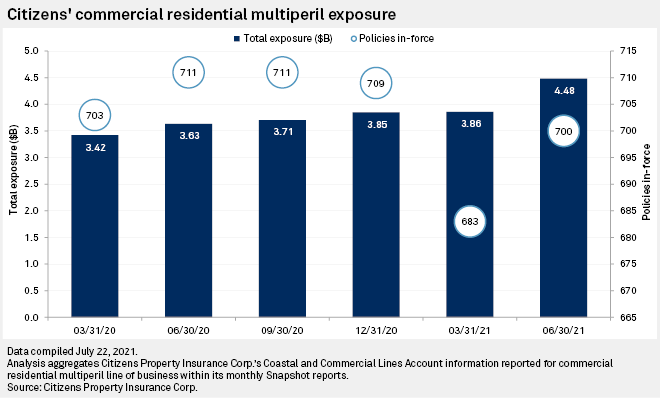S&P Global Offerings
Featured Topics
Featured Products
Events
S&P Global Offerings
Featured Topics
Featured Products
Events
S&P Global Offerings
Featured Topics
Featured Products
Events
Banking & Capital Markets
Economy & Finance
Energy Transition & Sustainability
Technology & Innovation
Podcasts & Newsletters
Banking & Capital Markets
Economy & Finance
Energy Transition & Sustainability
Technology & Innovation
Podcasts & Newsletters
S&P Global Offerings
Featured Topics
Featured Products
Events
26 Jul, 2021
By Calvin Trice and Jason Woleben
The deadly condominium collapse in Surfside, Fla., could reshape the way experts model catastrophe risk along a coastline that is already vulnerable to wind and water damage from tropical systems.
Structural considerations typically take into account how a building could withstand hurricanes, but the flaws suspected as culprits in the sudden destruction of Chaplain Towers South will add another layer to how modelers and underwriters determine risk. The official death toll from the collapse stands at 97.
The collapse and loss of life was "shocking and alarming" even to those who study loss exposure like CoreLogic Inc. engineer and risk modeler Tom Larsen. CoreLogic will investigate more buildings as part of its service, Larsen said in an interview.
"There is cause for that, and a pragmatic positioning is that we will find more buildings that are perhaps not close to imminent collapse but have had needs overlooked," he said. CoreLogic will await a detailed analysis behind the condominium's construction and maintenance before reevaluating its modeling, Larsen said.
"I expect that there will be multiple conclusions — not just a single aspect."
|
Recovery efforts following the late-June collapse of the Champlain Towers South condominium in Surfside, Fla. |
Florida officials do not expect to determine a definitive cause for the collapse for months, if not longer. An engineer that the property's association board hired to inspect the building informed members in 2018 that the foundation had significant damage, The New York Times reported.
If structural flaws discovered prove to be contributors to the collapse, the incident represents "a colossal failure" of risk management on the part of the board, said David Prager, managing director and insurance adviser with Kroll.
Members of volunteer boards tend to be chosen based more on personal popularity than on qualifications, Prager said in an interview, adding that responsible boards need to have a diverse set of expertise that would include knowledge of construction.
"If I'm sitting on a board, I need someone who can ask intelligent questions about an engineering report — be it another board member or a building manager," Prager said. Insurers could play an important role in lessening structural risks of cooperatively owned residential developments by requiring that governing boards have construction engineers available to the full board or committees, the Kroll executive added.
More awareness, less underwriting appetite
With awareness heightened regarding the structural integrity of older buildings, insurance demand on buildings like Chaplain Towers South will outstrip supply, for the time being, Prager said. Underwriters will be more cautious when taking on such risk and seek higher prices for those policies. Barry Gilway, president of Citizens Property Insurance Corp., referenced the newly appreciated statewide building risk in a report given to the insurer's governing board weeks after the Champlain Towers' destruction. Stricter underwriting standards will likely send more customers to Citizens as the state-run insurer of last resort, Gilway said in a statement.

Citizens has seen its commercial residential multiperil exposure rise steadily since the first quarter of 2020, to $4.48 billion as of June 30, 2021, according to an S&P Global Market Intelligence analysis. The agency's policies in force saw a quarterly drop in the first quarter to 683 from 709 before returning closer to normal levels in the second quarter.
Catastrophe risk modelers in Florida normally assess buildings' vulnerability based on their ability to withstand the impacts of hurricanes of various strength, said Joseph Petrelli, president of the Florida-focused rating agency Demotech Inc. Structural deficiencies like those suspected in the Chaplain Towers South collapse might not be properly accounted for, Petrelli said in an interview. There could be an underestimating of how vulnerable older condominiums are if their foundations are in bad shape, he said.
Demotech will maintain its ratings posture, for now, hoping that the Champlain Towers tragedy does not indicate more widespread risk, Petrelli added.
The Champlain Towers South structure was about 40 years old at the time of the collapse and up for inspection for recertification. Risk assessors wanting to gather construction and maintenance data for condominiums of that age or older will have a difficult time gathering it because the state's records on the buildings are kept on a county-by-county basis, said insurance consultant and former deputy insurance commissioner Lisa Miller.
Florida's older buildings need more frequent mandatory inspections, Miller said, adding that the Surfside tragedy offers a chance for regulators, insurers, and homeowners and their associations to reform construction and maintenance standards, Miller said. One of the most pressing reforms would be a modern database for condo records.
"A centralized database of all public documents that are required by statute [accessible] in one place would be a great start," Miller said in an interview.
